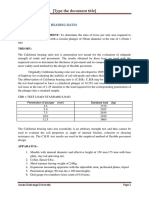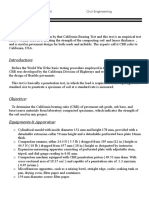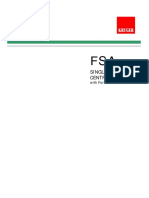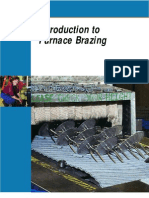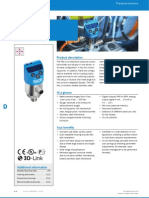Data Sheet California Bearing Ratio (CBR) (TEST METHOD BS 1377: PART 9: 1990)
Uploaded by
Dis ConnectData Sheet California Bearing Ratio (CBR) (TEST METHOD BS 1377: PART 9: 1990)
Uploaded by
Dis ConnectDATA SHEET
CALIFORNIA BEARING RATIO (CBR)
( TEST METHOD BS 1377 : PART 9 : 1990 )
PROJECT :
CONTRACTOR :
MATERIAL :
SAMPLE DESCRIPTION : DATE :
Proving ring : kN/Div = X 0.02
RESULTS
Penetration (mm) Dial Gauge Force (kN)
0.00 0 0.00
0.25 40 0.80
0.50 60 1.20
0.75 90 1.80
1.00 115 2.30
1.25 140 2.80
1.50 160 3.20
1.75 195 3.90
2.00 220 4.40
2.25 240 4.80
2.50 260 5.20
2.75 305 6.10
3.00 345 6.90
3.25 375 7.50
3.50 410 8.20
3.75 440 8.80
4.00 475 9.50
4.25 510 10.20
4.50 525 10.50
4.75 560 11.20
5.00 585 11.70
CALCULATIONS
Force = Dial gauge x 0.002
= 40 x 0.002
= 0.80 kN
𝐹𝑜𝑟𝑐𝑒(𝑘𝑁)×100
Penetration of 2.5 mm =
13.2
5.20(𝑘𝑁)×100
=
13.2
= 39.39 %
𝐹𝑜𝑟𝑐𝑒(𝑘𝑁)×100
Penetration of 5.0 mm =
20
11.70(𝑘𝑁)×100
=
20
= 58.50 %
SUMMARY
Penetration at 2.5 mm, CBR = 39.39 %
Penetration at 5.0 mm, CBR = 58.50 %
IN SITU CBR = 58.50 %
A Graph of Force Applied to Plunger (kN) versus Penetration of
Plunger (mm)
14
Force Applied to Plunger (kN)
12
10
0
0 0.25 0.5 0.75 1 1.25 1.5 1.75 2 2.25 2.5 2.75 3 3.25 3.5 3.75 4 4.25 4.5 4.75 5
Penetration of Plunger (mm)
DISCUSSION
Generally, CBR test is used to determine the strength of a sub-grade, sub-base and base
course materials and to measure the pressure required to penetrate a soil sample with a
plunger of standard area. And from the experiment, the measured pressure divided according
to the pressure required in order to achieve an equal penetration on a standard crushed rock
material. Based on the graph plotted, the loading rises as the penetration of plunger increases.
It is noticeable that the harder the surface, the higher it will be for CBR. Besides, as the
penetration increases, the dial gauge of division also increases. And eventually the force
applied to the plunger also increases. According to the JKR Standard, it is necessary to take
the CBR value of penetration of 2.5 mm and 5.0 mm. From the data calculated, the CBR value
for penetration of 2.5 mm is 39.39 % and 58.50 % for penetration of 5.0 mm. In most cases,
CBR decreases as the penetration increases and the ratio at penetration of 2.5 mm is used
as the CBR value for design purpose. If the value of penetration of 5.0 mm is greater than 2.5
mm, then it is necessary to repeat the test for checking purpose. In this experiment, the value
for penetration of 5.0 mm is greater than 2.5 mm. Therefore, it is necessary to repeat the test
and if the result collected is the same as the previous result, then penetration of 5.0 mm is
used for the CBR design purpose.
You might also like
- In-Situ California Bearing Ratio (CBR) TestNo ratings yetIn-Situ California Bearing Ratio (CBR) Test1 page
- Khwopa College of Engineering: Tribhuvan UniversityNo ratings yetKhwopa College of Engineering: Tribhuvan University9 pages
- Determination of California Bearing Ratio of Laboratory Compacted SoilsNo ratings yetDetermination of California Bearing Ratio of Laboratory Compacted Soils10 pages
- S11198623 - Adi Natalia Nacola - Lab FourNo ratings yetS11198623 - Adi Natalia Nacola - Lab Four10 pages
- California Bearing Ratio Test (IS: 2720-1979 (Part XVI) ) ObjectiveNo ratings yetCalifornia Bearing Ratio Test (IS: 2720-1979 (Part XVI) ) Objective11 pages
- (Type The Document Title) : Title - California Bearing RatioNo ratings yet(Type The Document Title) : Title - California Bearing Ratio7 pages
- University of Kirkuk College of Engineering Civil DepartmentNo ratings yetUniversity of Kirkuk College of Engineering Civil Department8 pages
- The Missing Link: California Bearing Ratio TestNo ratings yetThe Missing Link: California Bearing Ratio Test6 pages
- Experiment: 5 Soaked CBR Test Objective:: Straight EdgeNo ratings yetExperiment: 5 Soaked CBR Test Objective:: Straight Edge4 pages
- Californea Bearing Ratio Test (CBR) : Name: Zagros Othman AliNo ratings yetCalifornea Bearing Ratio Test (CBR) : Name: Zagros Othman Ali21 pages
- California Bearing Ratio (CBR) Method: Typical Testing MachineNo ratings yetCalifornia Bearing Ratio (CBR) Method: Typical Testing Machine21 pages
- Nust College of Civil Engineering Risalpur (Mce) : Lab Reports Transportation Engineering-Ii Field CBRNo ratings yetNust College of Civil Engineering Risalpur (Mce) : Lab Reports Transportation Engineering-Ii Field CBR5 pages
- CV311 - Lab 4 - Praveet Chand - S11196552No ratings yetCV311 - Lab 4 - Praveet Chand - S111965529 pages
- Highway Practical: University of Sulaimany Faculty of Engineering Building Construction DepartmentNo ratings yetHighway Practical: University of Sulaimany Faculty of Engineering Building Construction Department7 pages
- Transportation Engineering - Lab ReportNo ratings yetTransportation Engineering - Lab Report14 pages
- Density Lab Objective: To Measure The Mass and Volume of Various Metals, Then Graph The Data To Observe TheNo ratings yetDensity Lab Objective: To Measure The Mass and Volume of Various Metals, Then Graph The Data To Observe The3 pages
- McCool-DEVELOPMENT OF A PLUG ASSISTED THERMOFROMING SIMULATION-PaperNo ratings yetMcCool-DEVELOPMENT OF A PLUG ASSISTED THERMOFROMING SIMULATION-Paper4 pages
- Elliptic Systems of Phase Transition Type: Nicholas D. Alikakos Giorgio Fusco Panayotis SmyrnelisNo ratings yetElliptic Systems of Phase Transition Type: Nicholas D. Alikakos Giorgio Fusco Panayotis Smyrnelis349 pages
- Energy Methods in Structural Analysis: Version 2 CE IIT, KharagpurNo ratings yetEnergy Methods in Structural Analysis: Version 2 CE IIT, Kharagpur15 pages
- Laura Ruetsche - Interpreting Quantum Theories-Oxford University Press (2011)No ratings yetLaura Ruetsche - Interpreting Quantum Theories-Oxford University Press (2011)398 pages
- TL21035 - BTD3343 - Technical Report 1 - Final VersionNo ratings yetTL21035 - BTD3343 - Technical Report 1 - Final Version5 pages
- Acfrogan9tzrv7avskfdbffhv68kopikiqg P2kxtgz86f8b9hfrxta4sjk9apwnzonofbvxxg Dddpopzqpzp0pakxbq Tcyt4yzo5xor6w8zevdi4nm3w7l1elucjsfahsv Yuvxrdntbexpa5No ratings yetAcfrogan9tzrv7avskfdbffhv68kopikiqg P2kxtgz86f8b9hfrxta4sjk9apwnzonofbvxxg Dddpopzqpzp0pakxbq Tcyt4yzo5xor6w8zevdi4nm3w7l1elucjsfahsv Yuvxrdntbexpa57 pages
- Morphometric Analysis On Precambrian Rocks in Part of Cauvery Basin Chamarajanagar DistrictNo ratings yetMorphometric Analysis On Precambrian Rocks in Part of Cauvery Basin Chamarajanagar District16 pages
- Metallurgy & File Classification: Capital EndodonticsNo ratings yetMetallurgy & File Classification: Capital Endodontics26 pages
- Code Commentary: 12.14 - Splices of Reinforcement - General R12.14 - Splices of Reinforcement - GeneralNo ratings yetCode Commentary: 12.14 - Splices of Reinforcement - General R12.14 - Splices of Reinforcement - General1 page
- As 2703-2008 Vehicle Loop Detector SensorsNo ratings yetAs 2703-2008 Vehicle Loop Detector Sensors8 pages
- Chemical Analysis of Ferroniobium: Standard Test Methods ForNo ratings yetChemical Analysis of Ferroniobium: Standard Test Methods For6 pages
- 3 Quarter Examination IN Integrated ScienceNo ratings yet3 Quarter Examination IN Integrated Science4 pages
- Pulse-Width Modulation (PWM) Techniques: Instructor: Prof. Ali KeyhaniNo ratings yetPulse-Width Modulation (PWM) Techniques: Instructor: Prof. Ali Keyhani35 pages




















